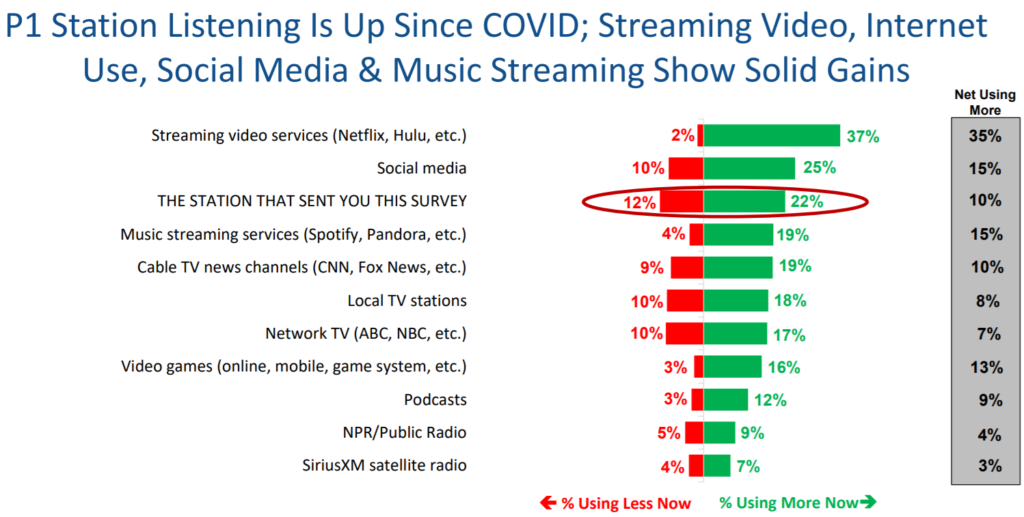There seems to be some confusion regarding whether the emerging social audio experiences compete with or complement podcast listening.
Let’s take a quick look at the motivations behind why people listen to audio and what format fits each mood and need.
Podcasts
In a recent in-depth survey by Cumulus Media, weekly podcast listeners were asked to identify the reasons for consuming different types of content.
It turns out that 61% of weekly podcast listeners do so for entertainment, followed by the desire to hear interesting stories (56%), and to learn something new (51%).
The one thing they all have in common is time.
The average podcast length is around 40 minutes, which may explain why heavy listeners (about 12% of the US population) listen to 6 or more hours a week, and usually in several sessions of a half-hour or more.
Podcast listeners often have a set of several shows they listen to regularly, and sometimes a few others they try from time to time.
According to one survey, podcast listeners consume about 8 episodes a week, on average. Heavy listeners listen to 11 episodes or more a week.

Personally, I like to listen to several dozen podcasts, but I rotate between cycles of several podcasts at a time, both because I can’t afford the time for more, and because I get overwhelmed by trying to keep track of so many shows. Imagine having 40 books on your nightstand.
If podcast listeners know which three, 10, or 40 sources they’re going to turn to, what about the other 2 million podcasts out there? We’ll get to that soon.
To recap, podcast listeners want to be entertained or learn something new, and they can normally dedicate 40 minutes at a time or more to tap into the same shows again and again.
Audiobooks
Let’s move on to Audiobooks. Why do people listen to them?
According to a survey from Jacobs Media Strategy, 31% of audiobook listeners do so while driving or commuting, 25% listen to books during housework or chores, and 18% while exercising.

This Reddit discussion reveals similar patterns – people are thirsty for knowledge, they would like to read more but don’t have the time or capacity to do so, and they consume audiobooks while commuting or doing chores such as cooking, gardening, etc.
While an audiobook can last tens of hours, listening time is normally akin to podcast listening.
In other words, audiobooks fill the same need as podcasts in terms of learning something new during long stretches of time. Their added benefits are the ability to follow longer, more complex narratives, and, of course, that sense of accomplishment associated with completing a book, even if it required less work than reading.
Short-form audio
As discussed, today’s podcast platforms do one thing well – deliver the episodes of the several shows you love straight to your ear. And this is great, if a listener knows what source he wants and has ample time to listen.
But short-form fills a completely different need. If a listener has minutes, not hours, and wants to listen to something interesting or informative, short-form content is the way to go.
When listeners want to discover interesting content and care more about the topic (say Tesla) than the specific source (say “Tesla Daily”), or want to be exposed to diverse points of view from various sources about the same content (say The Olympic Games), short-form audio is a better choice than podcasts.
With short-form, once topics of interest are defined or searched, a stream of concise, relevant clips make their way to the listener.
Here too, it’s not a competition. Short-form talk audio supplements listening to full podcasts; it doesn’t compete with it.
In fact, it supports long-form content creators because in the same 15 minutes one has to kill, he can be exposed to 5 different podcasts, instead of less than one. And this listener may just subscribe to one of those new podcasts and listen to it later, time permitting.
But what if, instead of the audio equivalent of Netflix binging, one feels like being with other people in the room and watching a play or a movie? For that, there’s Clubhouse.
Social Audio
Social audio is the new kid on the block, and while it is getting a lot of attention, it is still too early to assess its long-term viability and predict how people will adopt this type of listening.
What we do know is that social audio is, well…social.
While Facebook and WhatsApp and other platforms have launched or are about to launch voice messages, most Social Audio is not actually about having conversations.
If you think about it, very few users on these platforms are having actual conversations. Most people are just tuning in to listen to other people’s conversations.
But that doesn’t mean Social Audio isn’t social. Because these are real conversations by real people, in real-time, social audio does feel social. A clubhouse room feels very much like going to a conference and sitting in on a breakout session. People choose this breakout session because they care about the topic and because they want to hear these people speak about it. The chances of being called on to ask a question or comment are small.
Still, one wouldn’t attend a conference if one wants to be left alone.
Data is still limited, but I believe we will see that the average session duration on Clubhouse is pretty low. If most Clubhouse users are like the people I’ve spoken to about it (and like myself), they are hopping in and out of rooms and leaving more often than staying for an entire one-hour session.
And that’s OK. That’s a big part of the appeal of social audio.
So how do these four compare?
Most people who want to learn something and stick around will tune into a podcast or an audiobook.
If they have less time and feel like interacting with or feeling like they’re with others, social audio is the way to go.
And if they’re not feeling very social and want to make more of their limited time and discover great content from various sources, short-form audio is the answer.

